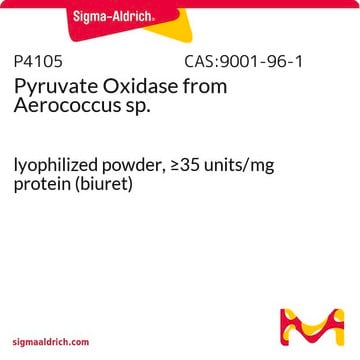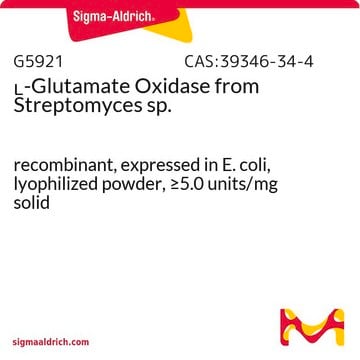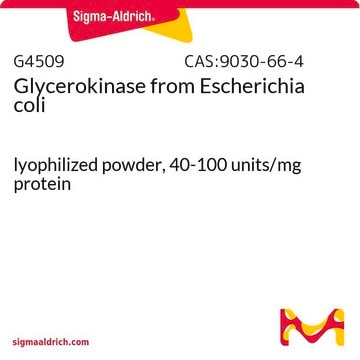The K12 strain information can be found on the UniProt website under the following entry: P0A9C5.
G1270
L-Glutamine Synthetase from Escherichia coli
lyophilized powder, 400-2,000 units/mg protein
Sinónimos:
L-Glutamate:ammonia ligase (ADP-forming)
Seleccione un Tamaño
Seleccione un Tamaño
About This Item
Productos recomendados
Formulario
lyophilized powder
Nivel de calidad
actividad específica
400-2,000 units/mg protein
purificado por
affinity chromatography
contiene
dithioerythritol as preservative
composición
Protein, ~5% Lowry
solubilidad
H2O: soluble 0.95-1.05 mg/mL, clear to hazy
Nº de acceso UniProt
actividad extraña
ATPase <0.2%
temp. de almacenamiento
−20°C
Información sobre el gen
Escherichia coli K12 ... glnA(948370)
Descripción general
Aplicación
Acciones bioquímicas o fisiológicas
Definición de unidad
Forma física
Palabra de señalización
Danger
Frases de peligro
Consejos de prudencia
Clasificaciones de peligro
Resp. Sens. 1
Código de clase de almacenamiento
11 - Combustible Solids
Clase de riesgo para el agua (WGK)
WGK 1
Punto de inflamabilidad (°F)
Not applicable
Punto de inflamabilidad (°C)
Not applicable
Equipo de protección personal
Eyeshields, Gloves, type N95 (US)
Elija entre una de las versiones más recientes:
Certificados de análisis (COA)
¿No ve la versión correcta?
Si necesita una versión concreta, puede buscar un certificado específico por el número de lote.
¿Ya tiene este producto?
Encuentre la documentación para los productos que ha comprado recientemente en la Biblioteca de documentos.
Los clientes también vieron
-
From which E. coli strain is your product G1270 L-Glutamine Synthetase from Escherichia coli isolated?
1 answer-
Helpful?
-
Active Filters
Nuestro equipo de científicos tiene experiencia en todas las áreas de investigación: Ciencias de la vida, Ciencia de los materiales, Síntesis química, Cromatografía, Analítica y muchas otras.
Póngase en contacto con el Servicio técnico












